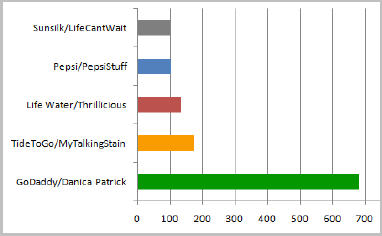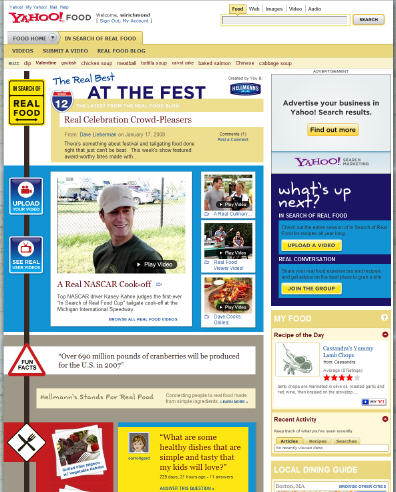-
A Little More Super Bowl Fun
OK, today no rant, just one more little insight to offer from Super Bowl ads.
Yesterday I highlighted the 5 ads (out of the total 52) which had a broadband component. They were:
GoDaddy - promoting Danica Patrick's "Exposure" banned ad and other videos
TideToGo - promoting "MyTalkingStain.com" a fun microsite
SoBe LifeWater - promoting "Thrillicious.com" a microsite where 2 more spots with the dancing lizards can be seen
Sunsilk - promoting "LifeCantWait.com", a microsite with a UGC contest which is not yet active
Pepsi - promoting "PepsiStuff.com", where users can download videos and music
I'm able to track click-throughs to each link I share in these emails. I thought you might be interested to see a graph of these clicks from yesterday. Note they're shown as an index, not actual numbers, with a starting index value of 100 for Sunsilk.

As you can see, VideoNuze email recipients expressed a pretty strong interest in the GoDaddy.com Danica Patrick ad. I'm sure many of you are not surprised since it has a pretty overt potential payoff for visitors.
Though the specifics of that payoff (is Danica actually going to remove her jacket and expose herself?) are very enticing, I think the larger issue to pay attention to is: how can advertisers explicitly use suspense, uncertainty and payoff to drive audiences to do something? Here's the last frame of the Danica spot:

To make this more tangible, consider this: The SoBe LifeWater ad was easily the most impressive use of special effects of all the Super Bowl ads. No doubt the SoBe LifeWater folks spent heavily making the ad, and then paying supermodel Naomi Campbell to dance with the pack of lizards to Michael Jackson's "Thriller." It certainly qualifies as the kind of thing that people would be interested in seeing more of, had SoBe LifeWater teased fans the right way at the end of the ad.
But they didn't. Instead, they simply flashed the URL "Thrillicios.com" at the end of the spot. Nothing was said about what to expect there, why you should go there, what surprises were in store, etc. (In fact there are 2 very funny and clever "episodes". And by the way, does this imply a new Life Water iguana series? Who knows?). Here's the last frame of the SoBe spot:

The point is this: I think SoBe LifeWater missed a huge opportunity to keep viewers engaged, which would have both improved the ROI on their Super Bowl ad spend, and also deepened viewers' engagement with the brand. While the Campbell spot was hugely entertaining, it did little to power ongoing engagement. Contrast this with GoDaddy, which no doubt had people pouring into its web site since the spot ran, with ongoing chatter and brand-building taking place.
As I said yesterday, advertisers need to understand how to use broadband video to evolve Super Bowl ads from having big-time entertainment value to having big-time engagement value. Some like GoDaddy get this, while many others, like SoBe LifeWater, are still on the learning curve.
What do you think? Post a comment and let us know!Addendum - I missed this piece in AdAge "GoDaddy Super Bowl Spot Sets Web-Traffic Record." The "Exposure" on-air ad drove 2 million visits to the site, during the game alone, a record for GoDaddy since it began advertising on the Super Bowl. And no doubt a multiple of that since the game ended. More evidence that GoDaddy nailed it big-time.Categories: Brand Marketing, Sports
Topics: GoDaddy, Life Water, Pepsi, Sunsilk, Super Bowl, TideToGo
-
My Rant About Super Bowl Ads
I love the Super Bowl ads as much as anyone. I never stop being amazed by the creativity and humor on display during each year's big game. This year was no exception: screeching squirrels, a strutting heart,
 shrunken heads, talking babies, the list goes on. For what Super Bowls ads are and always have been, they're terrific. My problem is that I believe broadband video allows Super Bowl ads to be much more than what they are and always have been. But the agency world does not seem to be getting this message.
shrunken heads, talking babies, the list goes on. For what Super Bowls ads are and always have been, they're terrific. My problem is that I believe broadband video allows Super Bowl ads to be much more than what they are and always have been. But the agency world does not seem to be getting this message.Two years ago I wrote "The Ten Million Dollar Super Bowl Ad?", where I outlined a scenario under which a 30 second spot could someday go for ten million bucks. How? By combining the best of brand advertising (the big emotional play) with the best of online advertising (the big measurable, performance-oriented play).
I wrote in that post: "What I envision is that the 30-second spot during the game will become the viewer's introduction or re-introduction to the brand or product. Numerous online, broadband-centric tactics will follow, with video being the center of the action. In football terms, the 30-second spot will morph from throwing a long pass (which is accompanied by high drama, but low probability of an actual score) to executing a more consistent ground game (accompanied by lower drama, but a much higher probability of an actual score). With this added measurability and a direct feedback loop, marketers will have much less anxiety about whether to ante up for the big game (and therefore the price will spiral upward).
I thought agencies and marketers would see this light and rush toward it. Boy was I over-optimistic. After watching all 52 Super Bowl ads this morning (thanks AOL), I am completely dismayed to report that, by my count, only 5 ads had any broadband video component:
GoDaddy - promoting Danica Patrick's "Exposure" banned ad and other videos
TideToGo - promoting "MyTalkingStain.com" a fun microsite
Life Water - promoting "Thrillicious.com" a microsite with a 2nd spot with the dancing iguanas
Sunsilk - promoting "LifeCantWait.com", a microsite with a UGC contest which is not yet active
Pepsi - promoting "PepsiStuff.com", with Amazon (ok, more focused on music than video)
All of the other 47 ads, representing tens of millions of dollars of clients' money, followed the same game plan from Super Bowls' past: go for either the clever, the funny or the gross, in an attempt to create buzz and fond memories for fans.
For me, this hidebound behavior showcases agencies at their most disappointing: unable to break out of the box, recognize new consumer engagement opportunities for their clients or embrace new technologies. Their inability or unwillingness to be more progressive is at the heart of why the whole advertising industry is in such chaos, with an increasing share of total spending shifting to online each year.
Nonetheless, I remain a long-term optimist. Maybe I'm crazy, but I'm still betting that someday, somehow, more agencies and brands will wake up and realize what the 5 brands above did this year: the combination of on-air and broadband is how to score a touchdown.
What do you think? Post a comment and let us all know!
Categories: Advertising, Sports
Topics: GoDaddy, Life Water, Pepsi, Sunsilk, Super Bowl, TideToGo
-
Microsoft, Yahoo and Broadband Video
Well, here I was waiting for news to officially cross the wire that Yahoo was acquiring Maven Networks for $150-$170 million (heavily rumored in the blogosphere yesterday and for weeks now) so that I could weigh in, when instead what emerged this morning was that Microsoft is making an unsolicited offer for Yahoo. Quite a day for Yahoo. (Note, I'll have more on Yahoo-Maven if and when that becomes official).
Today's big news is Microsoft's unsolicited $44.6B offer for Yahoo. Talks between the companies have been off and on for a long time, and it looks like Microsoft finally got fed up with the dithering at Yahoo and
 decided to make a pre-emptive move. Steve Ballmer's letter to Yahoo's board and today's release is here.
decided to make a pre-emptive move. Steve Ballmer's letter to Yahoo's board and today's release is here. The deal is all about increasing scale to compete more effectively with Google in the online advertising space. Both Microsoft and Yahoo have lagged Google badly and have spent billions in the past year on ad infrastructure acquisitions. Yahoo immediately brings MSN lots of new traffic, which can be monetized with both search and display advertising.
Though Ballmer's letter also highlights "emerging user experiences" such as video, mobile, online commerce, social media and social platforms" down the list, as the fourth area of potential synergies, I would argue that
 the upside in video is actually the most strategic benefit of the deal. Why?
the upside in video is actually the most strategic benefit of the deal. Why?The concept of scale, i.e. being able to both reach gigantic audiences and drive massive traffic from them, is absolutely essential for broadband video advertising to become core part of the marketing mix for big brands. Unlike search-based advertising, which has been driven by long-tail advertisers, broadband video advertising is going to be driven by big brands. That's because, notwithstanding the growth of overlays and other formats, pre-, mid- and post-roll ads are going to be with us for a while to come, and they are expensive to produce. The average garage-sized business isn't going to be making them.
Big brands spend tens of billions of dollars on TV ads. Shifting a meaningful part of this spending to broadband delivery is essential for broadband's growth. Brands spend on TV because that's been the only way for them to buy enough audience reach. Though they're beginning to trickle some spending over to broadband, the central obstacle to increasing their broadband spending is that there simply is not enough high quality, targeted video inventory for them to buy in order to achieve their reach objectives and therefore materially impact their businesses.
This is a theme I hear all the time, and just heard many times in the ad-related sessions I attended at NATPE earlier this week. Microsoft knows that to tap the long-term broadband ad opportunity in branded video advertising, it must offer advertisers greater reach, along with interactivity, reporting, social features, etc. This is all the more urgent because MSN and Yahoo are already playing catch-up to YouTube which still drive approximately 40% of all video views, a dominant market position.
MSN has worked hard to cross-promote MSN video in the rest of the site, and this has driven improved user experiences and impressive traffic gains. Yahoo, which has been mired down with a dysfunctional and bloated bureaucracy, has been far less coordinated and effective in video, leaving lots of room for MSN to make improvements.
You won't hear much about video as a key motivator for the deal because Wall Street, which is Microsoft's key audience to persuade, doesn't give a whit about long-term strategic positioning. It only cares about short-term financial metrics like dilution, earnings growth, cost-reductions and so forth. But behind the scenes, I'm giving credit to Microsoft. I think it is reading the tea leaves correctly about how the broadband video ad market is going to unfold and how to get MSN positioned properly for long-term success.
What do you think? Post a comment!
Categories: Advertising, Deals & Financings, Portals
-
Test 2
Test 2 -
Test post
Test post -
More Nuze on Branded Entertainment
Hey, maybe I should go into scripted programming...no sooner did I post "Branded Entertainment is Upon Us" this morning, than AdAge is running "Dorm-Life Opens Doors to Initiative."
The piece is all about how Initiative Media has partnered with the webisode's producer, Attention Span Media to do secure sponsor tie-ins. Initiative sports clients such as Carl's Jr, Cadbury-Schweppes and Victoria's Secret, all of whom are no doubt eager to reach the program's target audience.
Echoing the theme of my post, and Shelly Lazarus's presentation at NATPE yesterday, AdAge quotes Jon Haber, director of Initiative Media's innovations department as follows: "...for your advertising to be noticed, your advertising has to be content."
Yes, the age of branded entertainment is clearly upon us.
Categories: Brand Marketing
Topics: Attention Span Media, Initiative Media
-
Branded Entertainment is Upon Us
If you had any doubts that brand marketing and entertainment programming are converging, an hour spent
 listening to a presentation at the NATPE conference yesterday by Shelly Lazarus, Chairman and CEO of Oglivy & Mather Worldwide would have quashed them in a hurry.
listening to a presentation at the NATPE conference yesterday by Shelly Lazarus, Chairman and CEO of Oglivy & Mather Worldwide would have quashed them in a hurry. This new reality is a direct result of the audience-fractured, advertising-averse world in which we now live. Ms. Lazarus believes that for agencies, "the challenge as stewards of brands is to help them tell a better story." In fact, telling a better story (the traditional agency imperative, I would argue) is no longer sufficient, as Ms. Lazarus continued: "Now brands need to be a part of the content story."
As such, she envisions far tighter links between ad agencies and the Hollywood creative community. Drawing a meaningful distinction about these industries' respective roles, she explained to the audience of content types: "We need all of you desperately...we can come up with a brand idea, but we can't do programming."

She emphasized repeatedly that to optimize the branded entertainment relationship, agencies and the advertisers they represent should not be called upon to "write a check" when production is virtually wrapped up. Rather, they should be brought in as early in the creative process as possible, and be provided an opportunity to help shape the story narrative and become a vital part of it.
Even while recognizing the role that brands have played since the early TV days of sponsored "soap operas", this proposed tight intertwining of advertising and programming will no doubt strike creative purists as heretical, while sending consumer protection advocates to DEFCON 5.
Regardless, the branded entertainment initiatives Oglivy is now encouraging its clients to selectively pursue reflects nothing more than the hard realities of today's complex and brutally competitive marketplace. Empowered by ever-stronger technologies - broadband chief among them - consumers are getting choosier in their media consumption habits, with advertisers and their messages getting the short end of the stick. With technology increasingly defining young people's lifestyles, this is a trend that will only intensify.
Faced with this daunting prospect, leaders in the agency world like Ms. Lazarus have astutely recognized that by carefully placing their clients' brands within the story line itself, they are creating a much-needed firewall, not to mention a breakthrough new consumer engagement opportunity. To be sure, branded entertainment is not a willy-nilly pursuit, at least not at Oglivy. The agency has set up a unit solely to create, execute and manage these opportunities. Listening to Ms. Lazarus, it was apparent that for all her enthusiasm for branded entertainment, she knows it's neither universally appropriate for all brands nor a catch-all cure to all that ails the industry.
Branded entertainment and broadband video are a perfect match in many respects. Broadband video's nascent development, combined with its still unclear monetization mechanisms and flexible/interactive capabilities make it fertile ground for agencies such as Oglivy to experiment.
So where specifically does all this lead? Three things I would bet on: more product-centric viral video initiatives like Dove's Evolution (presenting an opportunity for Dove - an Oglivy client - to "have a point of view about beauty," as Ms. Lazarus put it), more product sponsored and conceived programming (e.g. Hellmann's "In Search of Real Food" on Yahoo; Hellman's is another Oglivy client) and more user-generated video contests around products (e.g. Frito-Lay, Heinz, etc.).

Broadband video is flowering just as traditional advertising and entertainment forms are under increasing duress. As such, it will be an enormous sandbox for agencies, brands, content creators and their audiences to all play in.
Categories: Brand Marketing, Indie Video, Strategy, UGC
Topics: Oglivy
-
Zucker Preparing NBC for Broadband Era
Jeff Zucker, NBCU's president and CEO gave a stirring, candid keynote at the NATPE show yesterday, in which he essentially said that all the rules that the broadcast TV industry has lived by for six decades have now changed. It was a pretty blunt assessment, given in terms not often heard from PR-cautious CEOs.
I thought Zucker nailed it on the head when he said that "technology is transforming every part of our business," suggesting that to succeed in the future the company must re-engineer itself from top to bottom.
 The technology drivers - DVRs, broadband distribution, VOD, mobile and inexpensive production equipment are all leading to fundamental changes in distribution, advertising sales, marketing and content development.
The technology drivers - DVRs, broadband distribution, VOD, mobile and inexpensive production equipment are all leading to fundamental changes in distribution, advertising sales, marketing and content development. Zucker said that the "historic economic model supporting broadcast TV is wounded." This is well exemplified in the broadband space, where networks have eagerly pushed their hit programs online. Yet in referring to its broadband initiatives, Zucker acknowledged, "Our challenge with all these ventures is to effectively monetize them so that we do not end up trading analog dollars for digital pennies," noting "This is the Number 1 challenge for everyone in this industry today."
I believe many of the steps Zucker's taking will help surmount this challenge. They include: Improving the allocation of resources and efficiency of the pilot process to help NBC maximize the opportunity that the mass-scale broadcast business still provides. Expanding the marketing of its programs beyond traditional influencers to help tap into the water coolers of the digital age. Broadening the role of its stations encompassing all local media opportunities instead of just selling TV ad space to enhance their competitiveness. Setting up digital studios to produce content geared for the broadband and mobile to tap new audiences.
Listening to Zucker, I felt myself being optimistic about his leadership and the likelihood that his game plan will ultimately lead to a successful transformation of the business. It won't come without plenty of bumps in the road, but it did strike me as clear-headed thinking which was sensitive to the network's traditions, but not obsequious to them. Throughout his keynote, he repeatedly reminded the audience that great storytelling and content is what all matters. The story of how NBC and the other networks will learn to succeed in the broadband era is definitely one worth following.
Categories: Broadcasters
Topics: NBCU


